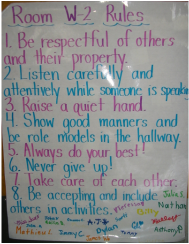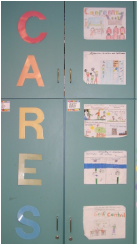Classroom Expectations: Responsive Classroom

I believe in the use of the Responsive Classroom approach to develop a positive and nurturing classroom environment where students feel safe taking risks.
Responsive Classroom is a teaching philosophy that is meant to foster respectful relationships and a positive environment within the classroom. Research associated with this approach has found that the greatest cognitive growth occurs through social interaction. Establishing respectful relationships within the classroom where students can work together effectively will provide a greater opportunity for collaborative learning. Principles supporting Responsive Classroom believe that in order to be successful academically and socially, children need a set of social skills: cooperation, assertion, responsibility, empathy, and self-control.
There are a set of practices at the core of Responsive Classroom:
- Morning Meeting (Interactive Greeting, Share, Activity, News and Announcements)
- Rule Creation
- Interactive Modeling
- Positive Teacher Language
- Logical Consequences
- Guided Discovery
- Academic Choice
- Classroom Organization
- Working with Families
- Collaborative Problem Solving
Rule Creation

As a class, we brainstormed and voted on important ideas that we felt should represent our expectations each day this year. Once rules were documented, each student then signed his/her name, thereby agreeing to the set expectations. This contract is displayed in our room as a helpful reminder of how we should conduct ourselves at all times during the day.
C.A.R.E.S.

The social skills of cooperation,
assertion, responsibility, empathy, and self-control (C.A.R.E.S.) are vital attributes necessary for social and academic growth and for the development of a positive learning community. The first few days of school students were split into groups and given one of the five skills. Students worked together designing a poster that would represent
what the attribute/skill meant in both words (definition) and pictures. By having students identify a real-life
situation to represent each skill, students were being provided with positive
examples of how they were expected to conduct themselves both inside and outside of the classroom.
